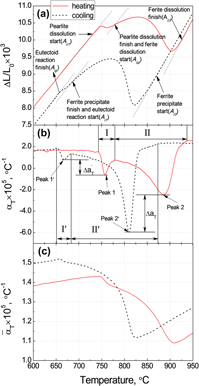Article contents
The effects of heating/cooling rate on the phase transformations and thermal expansion coefficient of C–Mn as-cast steel at elevated temperatures
Published online by Cambridge University Press: 23 June 2015
Abstract

Dilatometric studies of C–Mn hypoeutectoid steel with an as-cast structure were carried out to study the effects of the heating or cooling rate, heating and cooling process on phase transformation, and the thermal expansion coefficient. As the heating or cooling rate (Vc) increased, the characteristic temperatures of Ac1, Acp, and Ac3 also rose, while Ar3, Ar1, and Arp fell. In addition, the phase transformation temperature range (Ac3–Ac1) rose, while (Ar3–Arp) fell as the heating or cooling rate increased. At the same time, the maximum thermal expansion coefficients│αT│ between the heating and cooling processes during phase transformation showed significant differences, and the difference (│ΔαT│) in the maximum │αT│ between these processes increased along with the heating or cooling rate, and this is because of the different phase transformation rates, with regard to the change from austenite to ferrite on cooling and ferrite to austenite on heating. During the heating process, the phase transformation rate of ferrite to austenite first decreases and then increases as the temperature rises, and the phase transformation rate of austenite to ferrite first increases and then decreases during the cooling process. The evolution of carbon and substitutional alloying elements (Si and Mn) in austenite during heating and cooling is also analyzed in this work.
- Type
- Articles
- Information
- Copyright
- Copyright © Materials Research Society 2015
References
REFERENCES
- 9
- Cited by




